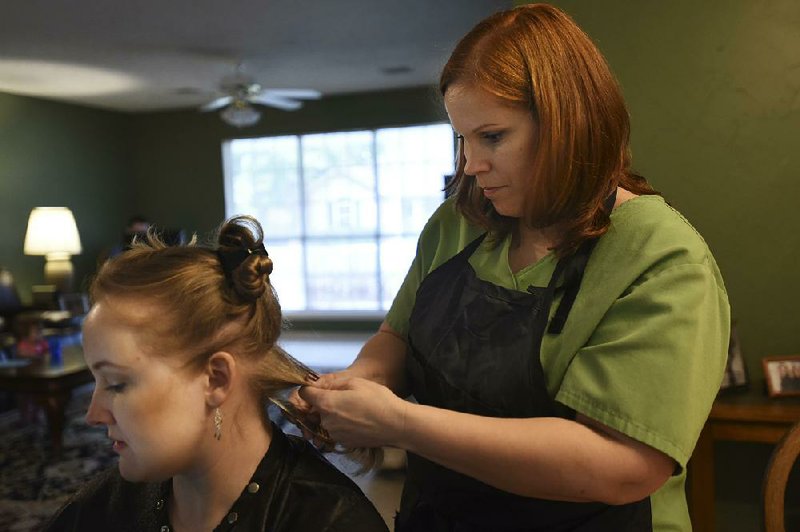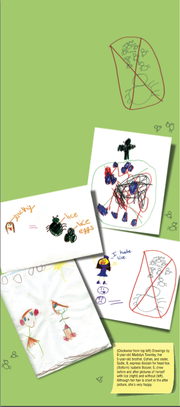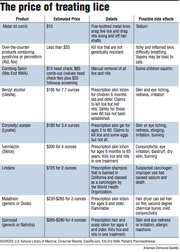During a recent convention of the American Chemical Society, two neurotoxicologists taped a news conference at which they discussed an already well-known development involving pediculus humanus capitis -- head lice.
Oddly enough, the Internet pulled up a chair.
Kyong S. Yoon and John Marshall Clark were talking about an ancient, teeny parasite that causes distress massively out of proportion to its size. Its adults are about the length of the all-caps "ONE" on the back of a penny; its eggs are as big as the penny's letter U. Causing no diseases, it can live only among the hairs on human heads.
The researchers announced that their genetic analysis shows resistance to the pesticides most commonly used against head lice is expanding on this continent. Lice from 25 states (including Arkansas) had genetic improvements (from the louse point of view) allowing the teensy parasites to survive being shampooed or rinsed with:
• pyrethrins, pesticides derived from daisy-like flowers, and
• pyrethroids -- their synthetic cousins, including permethrin.
These are the active ingredients in over-the-counter potions such as Rid and Nix.
The Internet leapt to its feet and shouted, OMG, unkillable super lice! Or something like that.
Yoon and Clark calmly added that since pyrethrins and -throids can't knock down all these lice, it would be smarter to stop reaching for the over-the-counter chemicals first and instead use one of the other treatments on the market. Two promising ones require a prescription. To avoid creating lice equally resistant
to those new chemicals, doctors should alternate their use.
This was Aug. 18 in Boston, the day Super Lice! Super Lice! were news.
About two weeks later, Paige Boozer was minding her job at Thompson Driving in Little Rock when her daughter's school, Pine Haven Elementary -- 20 miles away in Bauxite -- called. Five-year-old Isabelle was waiting in the office. Nurse Elana Johnson had found head lice in Isabelle's long, thick hair.
She and her little brother Levon rough and tumble all the time, so before Boozer started her car, she called his day care center, Adventure Land Academy in Little Rock, and asked the director to peer at his head. "Sure enough," she says.
Johnson sent Boozer home with enough Rid to treat both children. She included standard instructions school nurses have been giving unlucky parents for years:
• Check everyone else in the family for lice.
• Apply the potion to the hair, following the instructions on the label to the letter.
• Use a special fine-toothed comb to scrape every last louse and the eggs -- nits -- off the hairs, a few hairs at a time. Yes, this will take hours. Yes, children hate it.
• Repeat the Rid treatment as the label directs, in about a week.
• Using the highest heat settings, machine wash and dry clothing and bed linens and beloved stuffed toys and precious blankies and any other washable item the infested people have been in contact with over the past two days. Or dry-clean it. Or bag it in plastic trash bags and leave the bags tightly closed for two to three weeks.
• Soak all combs and hairbrushes in hot water for about 10 minutes.
• Optional extra work: Vacuum furniture and the car, discarding the filter and or bag in a trash can outside the house.
• Not optional: Recheck for lice every day or two.
Following new guidelines issued by the American Academy of Pediatrics in May (bit.ly/1VEMkEx), some schools allow children back into class immediately after they've been treated. But Pine Haven is among many Arkansas schools that retain a no-nit policy: Isabelle could not return to class until the nurse declared her hair absolutely nit free.
Boozer does not live under a rock. "I've heard there's like a super bug of lice," she says. So just in case the school nurse was behind the times in assuring her Rid would work, "I went ahead and called Isabelle's pediatrician at Arkansas Children's Hospital and talked to him about it."
The pediatrician agreed with the school nurse. "So I just trusted them and followed the instructions," Boozer says. "And it seems to have worked."
STILL EFFECTIVE?
Originally derived from flowers and considered safe for people (as safe as pesticides get), pyrethrins kill not-resistant lice by disrupting electrical activity in the louse nervous system. They attack a specific feature of many creatures' nervous systems, voltage-sensitive sodium channels. Disrupting ion transfers there paralyzes a louse -- unless the louse is just a little different from other lice, having sodium channels that work in a broader range of conditions.
That louse will survive exposure that kills the other lice. Add it to the nits that also tend to withstand chemical treatment longer. Unless combed off the head, they endure, producing increasingly resistant offspring.
At his August presentation, Yoon noted that such head lice first were observed in Israel in the 1990s. The existence of resistant lice is not debated.
So why are school nurses and doctors standing by trying an over-the-counter product first? Why not advise heading straight to the doctor for a prescription?
Dr. Carrie Brown, a pediatrician at Arkansas Children's Hospital, sympathizes all too well with the (many, many) families who bring louse-ridden youngsters to her for help.
"Both my kids got head lice at summer camp two years ago. It was a nightmare," she says. "We are not changing our advice, and we're not changing it for a few reasons. One of those reasons is that these super lice that these researchers have determined ... their sample size from the state of Arkansas was incredibly small."
Researcher Clark, director of the Massachusetts Pesticide Analysis Laboratory at the University of Massachusetts-Amherst, told the Democrat-Gazette that about 400 lice were collected from five sites in north central and eastern Arkansas, and of those, 50 or 60 randomly chosen lice were tested.
"Number 2," Brown says, "the alternatives that they're suggesting are stronger, more potent things that come with their own set of side effects."
The two prescription pesticides the researchers suggested were ivermectin, whose discoverers earned the Nobel Prize in medicine last week; and spinosad, a scalp lotion that can kill lice and nits in one treatment, without combing. As explained by a 2012 article in the peer-reviewed newsletter Pediatric Pharmacotherapy ("New options for eradicating resistant head lice"), spinosad overexcites the louse nervous system, leading to exhaustion, paralysis and death; ivermectin binds to receptors that control how much chloride enters louse nerve and muscle cells, resulting in paralysis and death. In other words, they don't attack what pyrethrins attack.
The American Academy of Pediatrics continues to recommend over-the-counter products -- unless. "Unless resistance to these products has been proven in the community, 1 percent permethrin or pyrethrins can be used for treatment of active infestations," its School Health Council policy statement, updated in May, states.
Where resistance is proved, the council supports the alternatives. In a "Health Issues" article published Sept. 24 ("Head Lice Treatment Myths & Realities," bit.ly/1VEU9Kl), the School Health Council notes that the newer prescription-only drugs are not riskier than over-the-counter formulas when used as directed. (Before 1990, Nix was prescription-only.)
But they are pricier, Brown says. Over-the-counter treatments cost less than $20; spinosad and ivermectin cost $265 to $300 (see accompanying chart).
Brown and other doctors at Children's Hospital are not persuaded that resistance is widespread in Arkansas. "The issue that we have where parents will come back and say, 'These head lice didn't go away,' most of the time, in our experience, it's because the parents didn't get all the eggs and nits off the hair shafts, which requires a long time and lot of effort and combing with that little teeny tiny lice comb, or they didn't clean the environment," she says.
"So they didn't bag up the clothes and stuffed animals and other things, didn't wash the sheets in hot water, didn't get rid of it from their homes or other homes that the children are going to."
But to Clark, the pediatricians are missing the point. Finding genetic traits for pesticide resistance doesn't mean a chemical won't kill any lice. It means it takes a longer exposure and more chemical to kill them, and meanwhile, that very effort builds the trait into more of the population by killing off all the lice that don't have it. Once the trait is established, a population cannot ever lose its pesticide resistance, unless every survivor that carries that trait is killed using some other method.
"They have stopped using the pyrethroid-containing compounds everywhere else in the world," Clark told the Democrat-Gazette. "They don't use them in South America. They don't use them in Canada. They don't use them in Europe. They don't use them in Asia.
"That should tell you something."
NITPICKING
Chemicals aren't required to kill head lice. Combing lice off your head until all of them and all of their eggs are gone "totally works, guaranteed," says Sarah Graham, owner of Nits End NWA lice removal service in Bella Vista. Her motto: If it's off your head, it's dead.
And according to the Centers for Disease Control and Prevention description of louse biology, she's correct. Human head lice cannot survive anyplace except atop a human head.
"Kudos to her for making a business out of it," Paige Boozer says. There is "no way" she would ever, ever have thought of doing that.
"The comb bristles are so thin you do end up having to get between every single strand of hair," Boozer says. "And it was gross because as you're doing that you're picking up dead lice and parasites and their sacks and stuff, and you see it on the brush with the conditioner stuff they give you. It's pretty nasty, and it took a long time."
The tangling and tugging hurt her daughter and damaged her hair. "I did both of their hair in one night waiting for my husband to get home from work," Boozer says, "and by the time he got home I was almost in tears."
Whatever drew Graham to such work? "I got into it when the nurse called me and told me that my own child had it. That was about three years ago. I started combing just within my circle of friends and the community, helping out, and the next thing I know, I'm getting calls from strangers. And then the next thing I know, within a year, the last two years, I'm combing people outside of the region," she says.
"In January we're actually going to be expanding a little bit and hiring more people and going full time with it, just full fledged."
People come to her home and pay her to comb away head lice, $85 for the comb-out and $25 for a followup.
Their children give her flowers.
ActiveStyle on 10/12/2015




